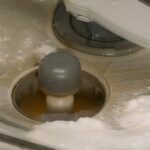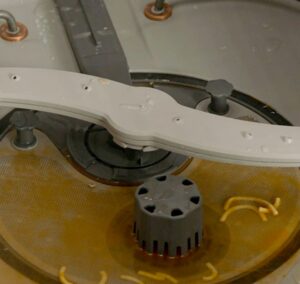You’ve just finished hosting a dinner party at your home, leaving you to wash the dishes now that everyone has left. You can rely on your dishwasher to speed up the clean-up process. However, after one cycle, you realize that your dishwasher won’t drain. A dishwasher that won’t drain can be incredibly frustrating, especially if you’re being taunted by the stacks of dirty dishes and utensils sitting in your sink. Before you panic, take a deep breath and continue reading so you know what to do when your dishwasher won’t drain after a cycle.
What To Do When Your Dishwasher Won’t Drain
As you read through what to do when your dishwasher won’t drain, you’ll also gain insight into what might be causing your dishwasher not to drain in the first place. After calming down, check out a few ways to troubleshoot a stubborn dishwasher.
Check The Garbage Disposal
The garbage disposal is the first part of your dishwasher you’ll want to check when determining why it won’t drain. This part is what helps remove any gunk from your sink. To check your garbage disposal, check if there are any visible signs of food buildup. If so, you can run the garbage disposal with just running water.
You can add a garbage disposal cleaner solution or a homemade mixture of vinegar and baking soda to help unclog it. Another strategy is plunging the dishwasher. If none of these techniques work, call a plumber. If the garbage disposal isn’t the reason why your dishwasher won’t drain, examine these other components.
Check The Drain Hose
Aside from a clogged garbage disposal, a clogged or damaged drain hose is the next most likely reason why your dishwasher won’t drain. It connects the drain line and pump and is often found beneath the sink. The first thing to check for is any signs of bending or twisting of the hose. Even if the hose seems to be in good condition, detach it carefully to check for any clogging on the inside. If anything is blocking the inside of the hose, carefully empty it.
Check The Air Gap Or High-Loop
Depending on the type of dishwasher you own, it might come with either an air gap or a high-loop. An air gap is the cylinder structure at the back of the kitchen sink that is meant to prevent air vacuums that could lead to standing water in the dishwasher. Conversely, a high-loop is found near the bottom of a countertop near the sink.
If your dishwasher uses an air gap, remove the air gap to check for anything that could be blocking it, and clean it out. To check a high-loop, see if it’s in the correct position in accordance with the user manual; if not, return it to the correct position. After checking this part, there’s one more part of your dishwasher you can still troubleshoot on your own.
Check The Filter
Your dishwasher’s filter is the last component you can safely troubleshoot on your own before calling a professional. Most filters are found at the bottom of the dishwasher, but you should still consult the user manual to be certain. Clean out the filter and see if anything is blocking it. If this troubleshooting technique doesn’t bear any results, it’s time to reach out to a professional.
Our Technicians Will Repair Any Dishwasher
Hopefully, the troubleshooting tips above are helpful starting points for what to do when your dishwasher won’t drain. If your dishwasher still doesn’t drain after trying these strategies, you’ll need an appliance technician to check it out. If you live in the Carrollton area, you only need to contact us at Appliance Repair Carrollton. Our technicians are equipped to diagnose and repair any dishwasher.


